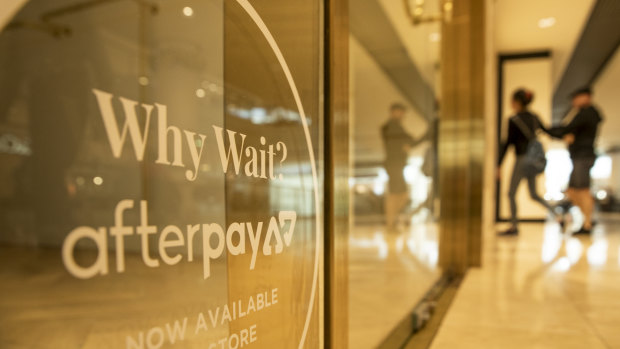By Cara Waters and Clancy Yeates
It was already one of the most divisive stocks in the market, thanks to its volatility and sky-high valuation, and now Afterpay investors are grappling with the idea of Square shares landing in their portfolio on the back of the proposed $39 billion tie-up between the two payments heavyweights.
Afterpay has had its fair share of doubters and true believers. Now the local market will need to get its head around Square, the payments behemoth started by Twitter billionaire Jack Dorsey, which will become one of the top 20 companies listed on the Australian Securities Exchange, provided the mega-deal goes ahead.
The all-scrip bid for Afterpay - the largest takeover in Australian history - allows Afterpay shareholders to either receive shares in Square listed locally on the ASX or on the New York Stock Exchange (NYSE).

Jack Dorsey of Square, left, and Anthony Eisen and Nicholas Molnar of Afterpay. The deal between the two groups may not be the last big one of this cycle. Credit:
Most Australians probably know more about Square’s enigmatic founder and chief executive than the business. But Square’s payment readers - the small, white plastic squares smaller than a mobile phone - have been popping up at cafes and small retail stores around the country since 2016.
The company, valued at $US129 billion ($174 billion), has subsequently expanded its products in Australia to include an ecommerce offering, loans and invoicing. Australia is Square’s biggest market outside the United States but it’s far from ubiquitous here.
Most of Square’s Australian customers are micro and small businesses, and while the entry costs to using its systems are low the fees it charges are often higher than competing payment systems and the big four banks.
A spokeswoman for Square declined to detail its number of Australian customers but the company recorded more than $US5 billion in revenue for the first quarter of the year globally and, according to Square’s earnings letter, it doubled its profit in Australia “due primarily to strong acquisition of new sellers and continued growth upmarket”.
Square’s former country manager for Australia, Ben Pfisterer, who left the payments company to start fintech Zeller, says Afterpay had popped up on Square’s radar a while ago.
Pfisterer, who helped make an initial introduction between Dorsey’s team and Afterpay co-founders Nick Molnar and Anthony Eisen, says while there was an immediate affinity between the parties an acquisition wasn’t on the table.
“When Nick was over in San Francisco four years ago, and I was over there too I arranged for him to come into the office and meet some of the executive team then because [Afterpay] was an amazing company back then and they continued to grow,” he says. “The timing wasn’t quite right, Square wasn’t interested in acquiring at that time.”
It wasn’t until 2021 in the wake of COVID-19 that the stars finally aligned with both companies big beneficiaries of the switch to cashless payments as a result of the pandemic.
Square shares jumped dramatically, rising 217 per cent in 2020, and are up a further 27.6 per cent this year.
Meanwhile, Afterpay’s rollercoaster ride saw its shares rocket from a low of just over $12 in March 2020 to a high of more than $150 last February.
Pandemic boosts aside, the tie-up also reflects how quickly things are moving in the buy now, pay later (BNPL) space, especially as a host of heavyweight competitors, including PayPal and potentially Apple, enter the fray.
With Afterpay’s future tied to success in the US market, Square offers Molnar and Eisen a viable exit.
Meanwhile from Square’s perspective, Afterpay provides the missing link that helps it package a BNPL option to the millions of merchants (mainly in the US) who processed $US38 billion worth of payments in the last quarter. It also offers Square a chance to cement relationships with Afterpay’s large global retail clients such as Amazon and Target.
Domm Holland, co-founder of e-commerce platform Fast, says the deal makes Square a much more formidable e-commerce player.
“Up until now they haven’t had any really sophisticated e-commerce offerings,” he says. “They’ve been very micro-business style e-commerce and now with Afterpay they’re establishing themselves as one of the most serious e-commerce players in the world in one brand.”
To its backers, Square has the long-term potential to become a payments “super app” on par with China’s WeChat pay - and they believe Afterpay can accelerate that process.
Square got its start providing payment services to small merchants through its ‘Seller’ app, but the company has also had success with its ‘Cash’ app (not available in Australia at this stage), which arranges peer-to-peer payments, and allows people to invest in shares and cryptocurrencies.
‘Most people used to having dealt with C-level executives would be incredibly shocked at the little amount he [Jack Dorsey] does contribute in a day-to-day meeting.’
Ben Pfisterer, Square’s former country manager
Portfolio manager at Munro Partners, Kieran Moore, says Afterpay could be the bridge that connects Square’s Cash and Seller apps, paving the way for it to become a payment “super app.”
“The Cash app really exploded in growth last year, and while the Seller ecosystem had a tough time with COVID, it’s back to strong growth this year,” Moore says. “Over the journey, Square shareholders have really questioned how they are going to connect these two ecosystems, and Afterpay can potentially unlock that for them.”
Munro, which manages about $5.5 billion in global equities, is a Square shareholder.
Investors will also keep a close eye on how Molnar and Eisen take to their roles at Square, with the Afterpay co-founders insisting they are staying on.

Afterpay has faced increased competition over recent months with both Apple and PayPal looking to compete with the company.Credit: Louie Douvis
According to Pfisterer, Dorsey will give the pair fairly free rein in their new roles, describing him as “very much a hands-off leader”.
“Most people used to having dealt with C-level executives would be incredibly shocked at the little amount he does contribute in a day-to-day meeting,” he says. “He will literally be in the meeting and observe and only really chime in when there was something of note, that he did or didn’t believe in.”
Given Molnar and Eisen’s track record so far, Dorsey’s hands-off style might be exactly what’s needed as Square sets its sights on hitting the big leagues.
Fund manager Hyperion Asset Management, which has about $1 billion in Afterpay shares, is confident about Square’s continued growth, in which it also holds a stake.
Chief investment officer Mark Arnold believes the company has the potential to expand for decades to come. He argues Square, like many tech companies, can benefit from “network effects” - the idea that a product becomes more valuable as it is used by more people.
“There’s a big incentive if you have got the app to encourage your friends and family to also use the app,” he says.
Arnold argues that integrating Afterpay’s almost 100,000 merchants and 16 million consumers can accelerate this process, and also help with Square’s expansion outside the US.
Looking into the longer term, he argues Square and Afterpay are in a strong position to disrupt the “old world” banking industry over the next couple of decades. “Eventually, a lot of people will never have a relationship with a bank because they won’t need to. All of their banking, and investment and credit requirements will come via a Cash app or an Afterpay-type app,” he says.
However, others are much more hesitant about Square as an investment. For one, big investors will find it harder to access management such as Dorsey, compared to the access they get to local executive teams. Some dual-listings have also seen liquidity in the ASX-listed shares dry up, which can be another turn-off.
An Afterpay insider, who wanted to remain anonymous, said many local shareholders may choose to sell out.
“It is now time as Kenny Rogers would say to know when to fold them,” he said. “Would you then hold Square shares? The company has increased in value so much over the last year. I would suggest that would put a lot of investors who are Australian into a space they are not really comfortable with and Dorsey has a polarising position in the market.”
The business itself is also sure to generate debate among investors, with several fund managers with Afterpay stakes not prepared to say if they would hold Square shares this week, as they need to learn more about the US business.
Wilson Asset Management portfolio manager Tobias Yao couldn’t comment on whether he would roll over Afterpay shares into Square stock due to compliance reasons, but he thinks there will be interest in the wider market.
“There is definitely an appetite to invest in Square given it’s on the forefront of disruption on the global stage. The strong growth profile, particularly post the merger with Afterpay, would be appealing to growth orientated investors,” Yao says.
However, Grant Halverson, who runs payments consultancy McLean Roche, says Square is still a small player in the business of providing payment services to merchants. While he says it has done well targeting small businesses, he estimates it processes about $4 billion in annual payments in Australia, compared with a market size of $700 billion.
“Jack Dorsey’s dream is to surpass PayPal and become a major player. Well he’s got a long way to go,” Halverson says.
Chief investment officer at Atlas Funds Management, Hugh Dive, says he will look at the stock given its size in the ASX 200 index, but it’s unlikely he would buy it.
Dive points out Afterpay was highly volatile - its share price frequently moved up or down by about 20 per cent during recent months. He believes Square would exhibit similar volatility. This is in part because of the intensity of competition in the sector, but also because “growth” stocks’ valuations can be heavily influenced by the outlook for interest rates.
As for the idea Square could one day challenge banks, Dive cautions about technology “evangelism,” saying it is important to be sceptical towards grand claims about taking over entire industries, as has been seen in previous tech booms.
“The view that they are going to take over the banking system is a bit of a heroic assumption,” Dive says.